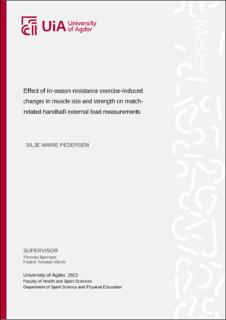Effect of in-season resistance exercise-induced changes in muscle size and strength on match-related handball external load measurements
Master thesis
Permanent lenke
https://hdl.handle.net/11250/3077285Utgivelsesdato
2023Metadata
Vis full innførselSamlinger
Sammendrag
Purpose: this study aimed to investigate if in-season resistance training-induced changes in maximal lower-body strength and fat-free mass could influence changes in match-related handball external load measurements. Method: twenty female handball players from two senior sub-elite teams (19.6 years ± 2.4, 168.7 cm ± 6.3 in height, and 69.3 kg ± 13.3 body mass) completed a 12-week in-season strength- and power training program. Players were then divided into high- and low-responders based on changes in squat 1 repetition maximum, leg press force, and leg fat-free mass (FFM). Improvements in FFM and one of the two strength tests that exceeded the smallest worthwhile change and coefficient of variation were defined as high-responders. Weekly standardized match-related handball external load was measured as Player Load and high intensity events (HIE) with inertial movement units. Changes in external load between high- and low-responders were analyzed with t-tests (three first- vs. three last measurements), single-cases with Nonoverlap of all Pairs (NAP) as well as correlations between changes in external load and the combined 1RM, force and FFM (composite change score). Results: There were no significant differences between or within responders in change in external load (p>0.05) or any correlations between changes in the composite score and external load (r= -0.04- -0.20, all p>0.05). The NAP analyses revealed no significant differences on an individual level (effect sizes: PlayerLoad: 0-0.66, HIE: 0.25-0.61). Conclusion: These findings indicate that changes in maximal leg extensor strength and fat-free mass do not influence match-related in-season handball PlayerLoad and HIE measurements.
Key-words: resistance training, handball, external load, PlayerLoad, high intensity events
